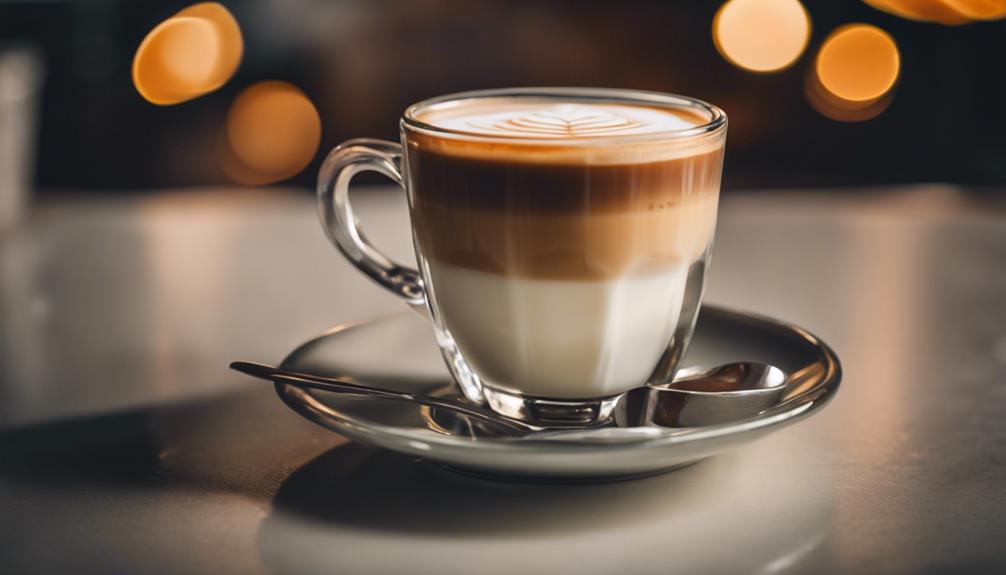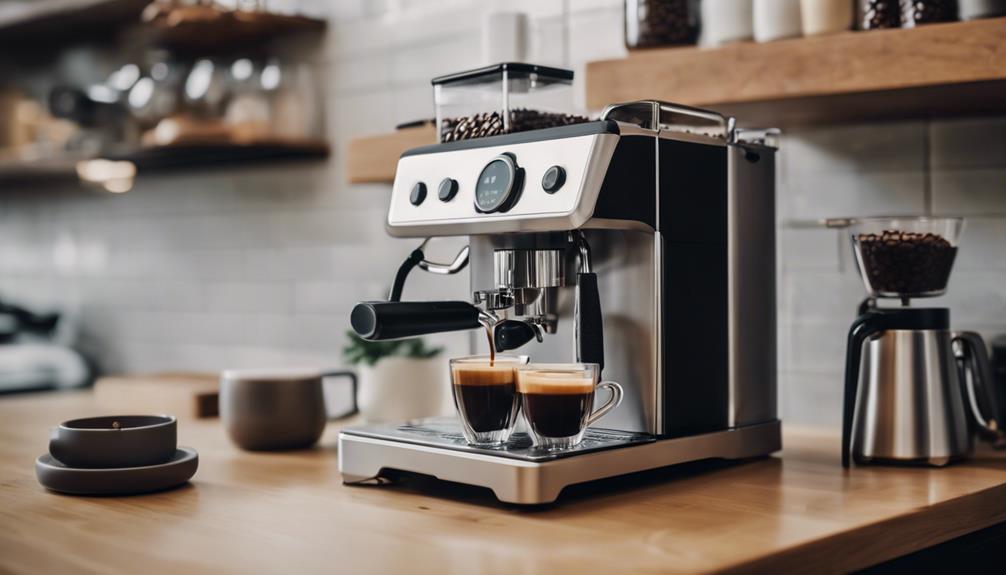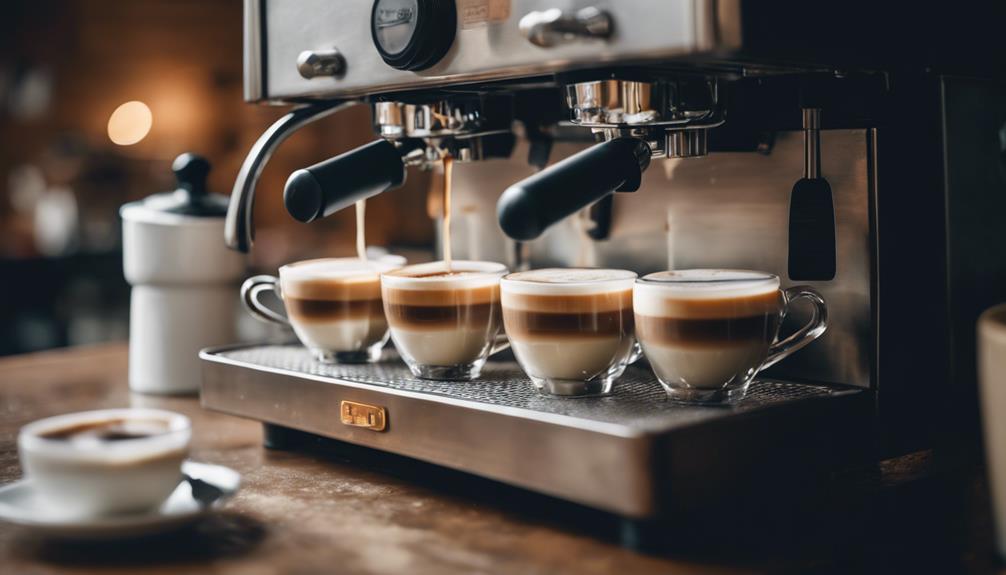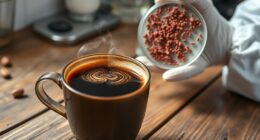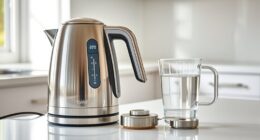In a small latte, you typically receive one espresso shot, containing around 63mg of caffeine. Various factors such as the size of the shot, personal taste preferences, and machine capabilities play a role in determining the number of shots. Baristas aim for consistency and quality by adjusting the shot count. Individual choices regarding flavor, strength, and caffeine levels can also affect how many shots are used. Maintaining a 1:2 ratio of espresso to milk is crucial for a well-balanced flavor. Modifying the number of shots can enhance the flavor profile, providing a range of taste experiences. Differences between cafes can influence the size of shots and taste consistency, contributing to the diverse world of coffee enjoyment.
Key Takeaways
- Small lattes typically contain one espresso shot for a balanced coffee flavor.
- Factors like shot size, machine capabilities, and personal preference determine shot count.
- Baristas adjust shot count based on expertise and taste preferences.
- Shot count can vary between cafes, with some opting for two shots for enhanced flavor.
- Experimentation with shot quantities allows for customization and flavor exploration.
The Standard Number of Espresso Shots
In a small latte, the essential number of espresso shots is typically one for a well-rounded coffee flavor. This single shot not only adds depth to your small latte but also provides around 63mg of caffeine, giving you that perfect morning kick-start.
Companies like Dunkin uphold this consistency by offering one shot in their small lattes, ensuring customers receive the expected taste and caffeine content. The espresso shot in a small latte plays a vital role in creating a rich and smooth coffee experience that many coffee enthusiasts crave.
It's no wonder that one espresso shot has become the go-to choice for those seeking a delightful coffee taste in their small latte. So, next time you order a small latte, rest assured that the one shot of espresso in it's carefully crafted to provide you with that satisfying coffee experience you love.
Factors Influencing Espresso Shot Count
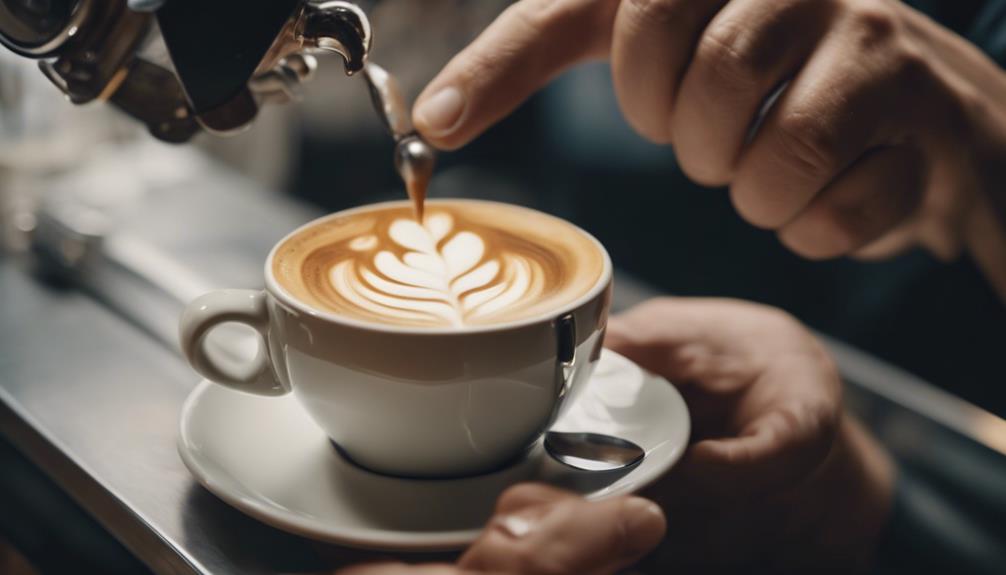
When determining the number of espresso shots in your small latte, consider factors like the size of the espresso shot, the skill level of the barista, and your personal preference.
The size of the espresso shot can affect the overall strength and flavor of your latte, while a skilled barista may adjust the shot count to meet your taste preferences.
Ultimately, your choice of espresso shot count can have a substantial impact on the quality of your small latte experience.
Espresso Shot Size
What factors influence the count of espresso shots in a small latte?
The size of an espresso shot, typically ranging from 7-20g, directly affects the number of shots used in a latte.
The amount of caffeine content desired in the drink and personal preferences for coffee strength also play a role in determining the shot count.
Machine capabilities and the type of roast used further impact the size and number of espresso shots in a small latte.
While some cafes stick to a standard of one shot for a small latte, others may opt for two shots to enhance the flavor profile.
Ultimately, the ideal espresso shot count in a small latte often comes down to personalization, allowing for variations based on individual taste preferences.
Keep in mind that the choice of espresso shot size can greatly influence the overall taste and strength of your small latte.
Barista Skill Level
Baristas' expertise greatly influences the number of espresso shots incorporated into a small latte. When it comes to crafting the perfect small latte, a barista's skill level plays an essential role.
Experienced baristas have the ability to adjust the shot count based on taste preferences and customer requests. They understand that consistency in shot count is important for maintaining quality in espresso beverages.
Baristas with training may vary the number of espresso shots to achieve the desired flavor profiles in a small latte. Proper shot extraction and milk steaming techniques are also key factors that impact the final espresso shot count in a small latte.
Personal Preference
Personal preference greatly influences the number of espresso shots you may choose to have in a small latte. Here are four key factors that can impact your decision:
- Coffee Flavor Preference: If you enjoy a more subtle coffee flavor, opting for a single espresso shot in your small latte might be the perfect choice. It provides a milder taste while still offering a hint of espresso.
- Intensity Preference: On the other hand, if you crave a robust espresso flavor and a stronger kick of caffeine, going for a double shot in your small latte could be more suitable. It enhances the intensity of the coffee and provides a bolder taste experience.
- Caffeine Content: The number of espresso shots directly affects the caffeine content in your small latte. Consider how much caffeine you desire in your drink when deciding on the shot count.
- Customization Options: Remember, baristas are skilled in adjusting espresso shot counts to match your preferences. Don't hesitate to communicate your desired coffee flavor and caffeine strength to tailor your small latte accordingly.
Personalizing Your Small Latte
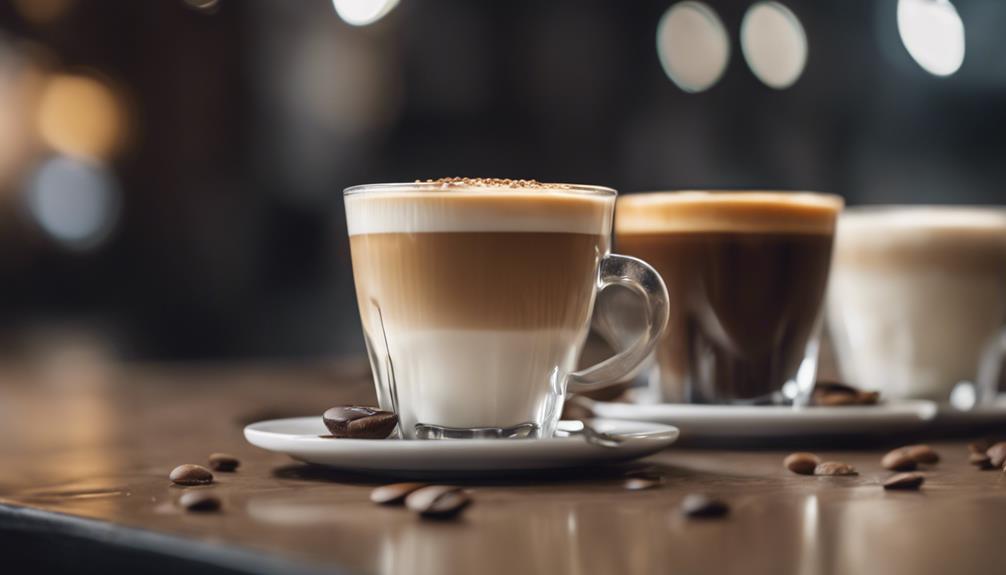
To customize your small latte, consider adding extra shots of espresso for a bolder flavor profile. While small lattes typically come with one shot of espresso, opting for extra espresso can intensify the coffee taste to better suit your preference.
This adjustment allows you to tailor the drink to your desired level of espresso strength. By experimenting with shot variations in your small latte, you have the flexibility to create a coffee experience that meets your specific taste requirements.
The 1:3 espresso-to-milk ratio in a small latte provides a smooth and flavorful base, and adding extra espresso shots can elevate the overall richness of the drink. Whether you enjoy a subtle caffeine kick or prefer a more robust coffee flavor, personalizing your small latte with extra shots of espresso offers a way to tailor your beverage to your liking.
Balancing Espresso and Milk

To achieve a well-rounded small latte, it's essential to take into account the espresso-to-milk ratio and how it impacts the flavor profile.
The balance between the intensity of the espresso shot and the creaminess of the milk is key to a satisfying coffee experience. By maintaining the right equilibrium, you can enjoy a consistent and enjoyable small latte every time.
Espresso-To-Milk Ratio
Achieving the perfect balance between espresso and milk is essential when crafting a small latte. Here are some key facts about the espresso-to-milk ratio in a small latte:
- A small latte typically contains one shot of espresso to maintain the ideal balance between the rich coffee flavor and creamy milk texture.
- The 1:2 espresso-to-milk ratio in a small latte guarantees a harmonious blend of flavors, allowing the coffee notes to shine through without overpowering the milk.
- The single espresso shot in a small latte provides a milder coffee experience compared to larger sizes, making it a perfect choice for those who prefer a less intense coffee flavor.
- Maintaining the right espresso-to-milk balance in a small latte is essential for enhancing the drink's taste and texture, creating a smooth and well-rounded beverage that pleases the palate. Remember, the small latte's espresso shot adds richness while complementing the steamed milk for a delightful coffee experience.
Flavor Profile Balance
Maintaining a harmonious flavor profile in a small latte involves skillfully balancing the boldness of espresso with the smoothness of steamed milk. The flavor balance between espresso and milk is essential for creating a satisfying coffee experience.
Typically, a small latte contains a ratio of 1/3 espresso to 2/3 steamed milk. The goal is to make sure that the espresso's robust and intense flavors complement the creamy and velvety texture of the milk.
By achieving the right mix of espresso and milk, you can savor a delightful and well-rounded taste in every sip of your small latte. This balance is what distinguishes a great small latte, where the espresso shines through without overpowering the milk, creating a perfect harmony of flavors.
Experimenting With Espresso Shots

When experimenting with espresso shots, consider the impact of adding an extra shot to your small latte for a bolder flavor experience. Here are some key points to keep in mind:
- Balancing Act: Adding an extra espresso shot can intensify the coffee flavor but may also affect the delicate ratio of espresso to milk in your small latte.
- Taste Testing: Experiment with different espresso shot quantities to find the perfect balance that suits your taste preferences.
- Strength Indicator: The number of espresso shots can serve as an indicator of the strength of your small latte, allowing you to customize your drink accordingly.
- Café Variability: Remember that espresso shot sizes can vary between cafes, so adding an extra shot mightn't always produce the same flavor profile.
Maximizing Flavor With Espresso Shots

To enhance the flavor profile of your small latte, consider experimenting with the number of espresso shots used. While a standard small latte traditionally includes one shot of espresso, some coffee enthusiasts opt for two shots to intensify the coffee taste.
Using an espresso machine, you can easily pull an extra shot to elevate the flavor complexity of your drink.
By incorporating two shots of espresso into your small latte, you can achieve a bolder and more robust coffee flavor that stands out amidst the frothed milk. The additional espresso shot adds depth and richness to your latte, creating a more intense sensory experience. The 1:2 ratio of espresso to milk still applies, ensuring a well-balanced beverage even with the increased espresso content.
Experimenting with two shots of espresso allows you to tailor your small latte to your preferred taste preferences. Whether you enjoy a stronger coffee presence or seek a more pronounced caffeine kick, adjusting the number of espresso shots can help you maximize the flavor potential of your drink.
Frequently Asked Questions
How Many Espresso Shots Does a Small Latte Have?
A small latte typically contains one espresso shot for a balanced coffee flavor. This standard shot count guarantees consistency across coffee shops and offers around 63mg of caffeine for a moderate energy boost.
By maintaining one shot, the milk-to-coffee ratio stays harmonious, catering to those preferring a milder coffee experience.
How Many Shots Are in a 16 Oz Latte?
In a 16 oz latte, the standard practice typically includes 2 shots of espresso. This balance between coffee and milk guarantees a consistent flavor profile and caffeine content.
While variations exist with 1 to 3 shots based on preference, the 2-shot standard maintains a harmonious blend of espresso strength and milk creaminess.
Adjusting the espresso shot quantity based on the latte size optimizes taste and richness for a satisfying coffee experience.
How Many Shots of Espresso Are in a 12 Oz Latte?
In a 12 oz latte, you'll typically find one shot of espresso. This single shot strikes a balance, ensuring a pleasant coffee flavor that pairs well with the milk.
The espresso shot's quantity in this size latte greatly influences both the caffeine content and taste profile of your drink.
Many coffee shops and cafes stick to this standard practice to maintain consistency and quality in their coffee offerings.
How Much Espresso to Make a Latte?
To make a latte, you typically need one shot of espresso. This shot, usually around 7-9 grams, contributes to the balanced coffee flavor in a small latte.
The espresso-to-milk ratio is essential for achieving the right taste and texture. With approximately 1 ounce of concentrated coffee from one shot, a small latte provides a milder coffee experience compared to larger sizes, perfect for those seeking a lighter caffeine kick.
Can I Use the Same Espresso Shots for Both a Small Latte and Cold Brew?
Yes, you can use the same ideal espresso shot ratio for cold brew and a small latte. The key is to use a 1:2 ratio of espresso to water for cold brew, and a 1:3 ratio for a small latte. This ensures the perfect balance of flavor in each drink.
Conclusion
In the world of small lattes, the perfect balance of espresso shots can elevate your coffee experience to new heights.
Experimenting with different shot counts allows you to tailor your drink to suit your individual taste preferences.
By finding the ideal combination of espresso and milk, you can create a flavorful and satisfying small latte that leaves your taste buds dancing with delight.
So go ahead, play around with those shots and discover your perfect brew!
